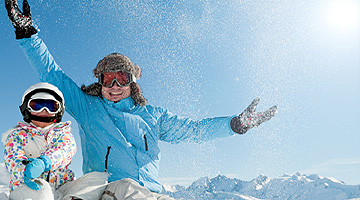Snow is falling along with the mercury as winter bites in the southern states of eastern Australia.
If you are heading for the snowfields, we’ve got some advice to keep you healthy and safe on the slopes.
1 - Invest in quality eyewear
Snow can reflect as much as 80% of the sun’s rays – much higher than the reflection off sand, water, or cement – and it comes into your eyes from all angles. The higher the elevation, the less atmosphere there is to filter out harmful UV rays.
Your snow eyewear should:
– Provide 100% protection against both UV-A and UV-B radiation.
– Fit your face snugly from above your eyebrows to the middle of your cheeks
– Wrap around your face so UV rays and wind can’t reach your eyes from the side.
Eyewear that meets Australian Standard AS1067 is a guarantee that it will block at least 95% of UV radiation. Glacier goggles (or glacier sunglasses) are the best option: They fit like sunglasses but screen out light from the sides. Your optometrist can also fit prescription lenses.
2 – Be aware of snow blindness
Goggles also protect you from a very painful corneal injury (UV solar keratopathy or ‘snow blindness’). Essentially it is sunburn of the eye’s surface.
Snow blindness feels like sand or grit in your eyes. Its symptoms include watering of the eyes, bloodshot eyes, and uncontrollable twitching of the eyelid. If you experience the symptoms you should:
– Remove contact lenses if you’re wearing them.
– Lie down in a darkened room.
– Cover your eyes with a cool compress or dark cloth.
– Refrain from rubbing your eyes.
Happily, almost all cases of snow blindness heal spontaneously over a few days.
3 - Don’t forget the sunscreen
Vacations that involve snow skiing (or mountain climbing or high-altitude trekking) have the potential for sunburn because of increased levels of UV. UV radiation exposure increases by 4% for every 300m of elevation above sea level.
Even on a cloudy day, sunscreen should be applied at a rate of 2mg per square centimetre of exposed skin. Properly applied, a sunscreen with an SPF of +15 will protect you from 93% of UVB radiation; while SPF +30 protects against 97% of UVB; and SPF +50 offers protection against 98% of UVB.
SPF 30+ is the recommended sunscreen for fair-skinned people who burn frequently and rarely (or never) tan. For those with light-intermediate, olive, brown, or black skin who tan easily and rarely (if ever) get sunburned, SPF 15+ offers sufficient protection.
It’s worth remembering that all UV damage lasts a lifetime and potentially fatal melanomas can occur anywhere on the human body – even in the eye. If you damage your eyes or skin, the long-term effects may only become apparent years – even decades – later.
4 – Respond to hypothermia
Even experienced skiers, snowboarders and alpine hikers can get caught out by a sudden change of weather that sends the mercury plummeting. So, it pays to be aware of two other potential risks on the snowfields, hypothermia and frostbite.
Hypothermia can occur if your body temperature falls just a couple of degrees to less than 35°C. The initial signs include feeling cold and shivering with pale skin, which can progress to feelings of fatigue or exhaustion, drowsiness, confusion, slurred speech, and memory loss.
There are steps you can take to help someone with hypothermia until medical help arrives:
- Get them to a warm space out of the wind and remove any wet clothing.
- Raise their core temperature by wrapping their head, neck, chest, and groin in a blanket (electric, if you have one) or warm them with skin-to-skin contact under blankets or sheets.
- If conscious, encourage them to sit up to drink warm, non-alcoholic beverages, such as tea or coffee.
- After raising their core temperature, keep them wrapped in a warm blanket – including their head and neck.
5 – Know some frosty first-aid
Frostbite is any injury caused by freezing; usually the nose, ears, cheeks, chin, fingers, or toes. Severe frostbite can lead to permanent tissue damage – even amputation – especially in people with poor blood circulation.
Tell-tale signs of frostbite include reddened skin progressing to a white or greyish-yellow colour that may also feel unusually firm or ‘waxy’, along with numbness and blistering. With more advanced frostbite, the skin may darken and turn black.
Victims of frostbite also need urgent medical treatment from a trained professional, but there are simple steps you can take to provide initial first-aid:
- Get them into a warm space.
- Immerse the affected areas of skin in warm water (not hot) or warm the affected area using body heat.
- Don’t massage the affected areas – it could cause more damage.
- Arrange transportation to medical help. Walking on frostbitten feet or toes may increase the damage, particularly as the thawing and re-freezing of feet after they’ve been warmed will increase the tissue damage.
6 – Take care out there!
With dozens of people of wildly varying skill levels likely to be on the slopes at any one time, safety is everyone’s responsibility.
Off-piste collisions with trees, rocks and covered obstacles can result in serious injuries that may require urgent evacuation. It’s one domestic travel situation when it is important to have travel health insurance that suits the type of activity you’re undertaking.
Finally, it’s always a good idea to take a pre-travel course in first-aid and emergency resuscitation (CPR). The knowledge will give you the confidence to provide what help you can.
Before you travel, call Travelvax Australia’s telephone advisory service on 1300 360 164 (toll-free from landlines) for country-specific advice and information. You can also make an appointment at your nearest Travelvax clinic to obtain vaccinations, medication to prevent or treat illness, and accessories for your journey.

